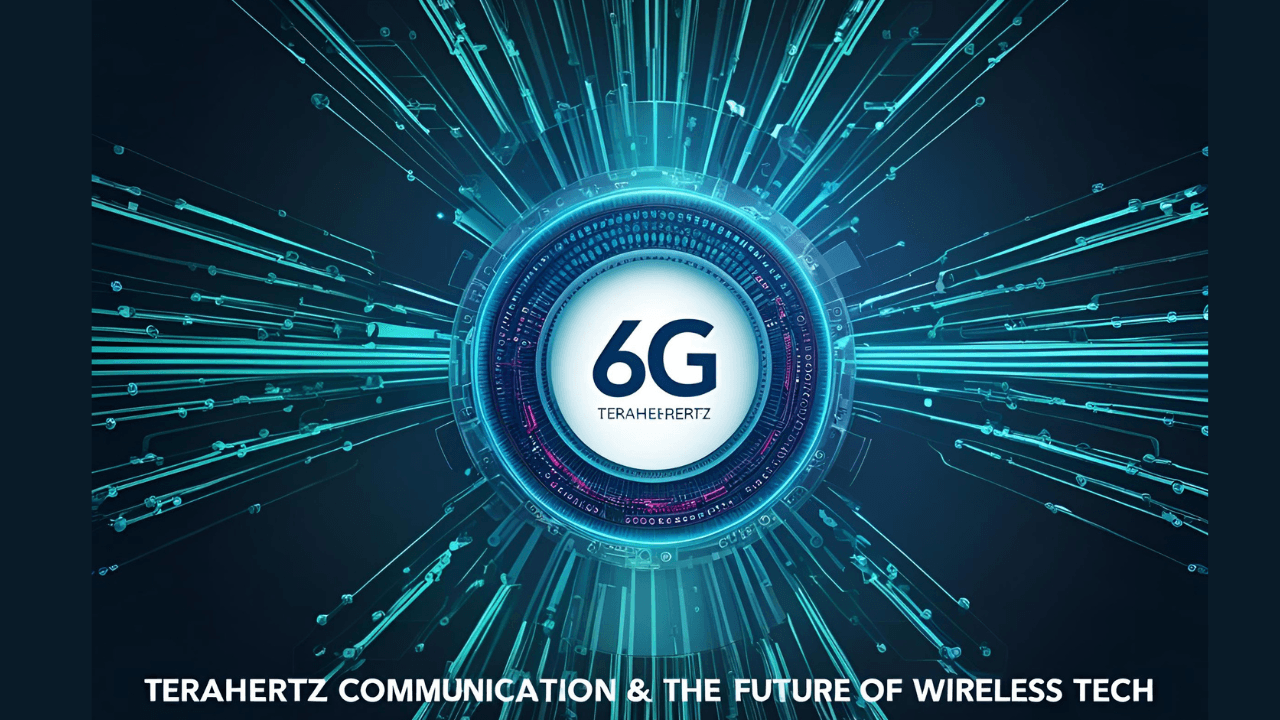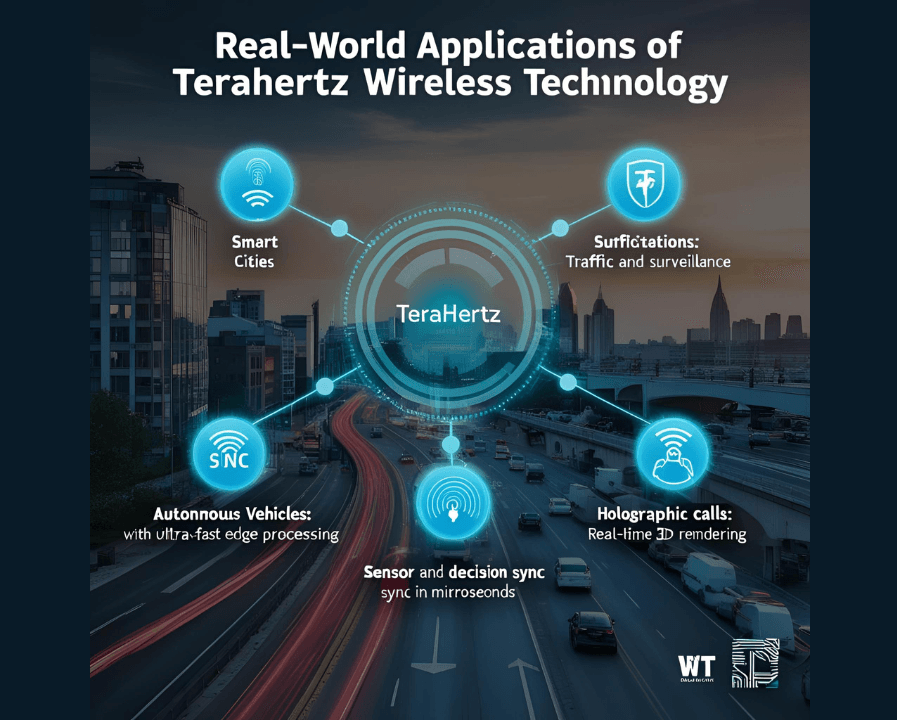Introduction: The Next Leap in Wireless Networks
The explosive growth of data-intensive technologies—such as augmented reality (AR), virtual reality (VR), autonomous vehicles, and real-time AI—has ushered in a new era of connectivity demands. These applications require ultra-fast, ultra-reliable, and ultra-low latency networks, which current 5G infrastructure struggles to support at scale.
While 5G has brought significant advancements, it faces key limitations:
- Limited bandwidth
- High energy consumption
- Infrastructure cost challenges
This paves the way for 6G network architecture, designed to exceed these constraints and support next-generation applications with lightning-fast speed and intelligent automation.

Two major enablers of this next leap are:
- Terahertz communication (THz) — promising wireless speeds up to 100 times faster than 5G by operating in the 0.1–10 THz frequency range.
- AI-native 6G core network configuration — embedding artificial intelligence directly into the network to enable self-optimizing, self-healing, and intelligent resource management.
Together, these technologies will shape the backbone of future wireless systems, bridging today’s limitations and tomorrow’s opportunities.
What Is Terahertz Communication?
Understanding Terahertz Frequency and Its Role in 6G
Terahertz communication operates in the terahertz frequency range, typically defined as 0.1 to 10 THz (terahertz = 1 trillion Hz). This frequency range falls between microwaves and infrared on the electromagnetic spectrum, commonly known as the “terahertz gap.”
Unlike traditional radio or microwave bands used in 4G and 5G, terahertz frequency opens up massive bandwidth potential, enabling data rates far beyond what current systems can support.

Why Terahertz Matters for 6G
The development of terahertz communication 6G aims to achieve:
- Capable of transmitting data at speeds reaching 1 terabit per second (Tbps).
- Sub-millisecond latency for real-time applications
- Spectral efficiency far exceeding today’s networks
- Support for ultra-dense environments (smart cities, IoT at scale)
These capabilities make terahertz communication a foundational pillar of 6G network architecture, allowing for seamless AR/VR, remote surgery, autonomous transportation, and real-time AI processing.
Scientific Momentum and Early Results
Although still in its infancy, terahertz communication 6G has already shown promise in lab experiments and field tests:
- University of Stuttgart (Germany) demonstrated 100 Gbps over a 20-meter distance at 0.3 THz.
- NTT and the Tokyo Institute of Technology successfully demonstrated data rates exceeding 300 Gbps using photonics-driven terahertz devices.
- Samsung and LG are actively testing THz chips in anticipation of commercial 6G rollouts by 2030.
These results validate the feasibility of terahertz frequency systems while highlighting the ongoing engineering challenges in range, antenna design, and signal penetration.
Frequency Spectrum Comparison Chart
| Band | Frequency | Usage |
|---|---|---|
| Microwave | 1 GHz–100 GHz | Wi-Fi, 4G, 5G |
| Terahertz (THz) | 0.1–10 THz | 6G, high-res imaging, advanced sensing |
| Infrared | 10 THz–100 THz | Fiber optics, thermal cameras |
Role of AI-Native Configurations in 6G Core Networks
AI-Native vs. AI-Enhanced: What’s the Difference?
In the context of 6G network architecture, it’s critical to distinguish between AI-enhanced and AI-native systems:
- AI-enhanced networks use AI as an add-on to optimize certain functions (e.g., traffic routing or user analytics).
- AI-native for 6G core network configuration, however, embeds AI deeply into the network’s DNA — enabling the system to self-learn, adapt, and optimize in real time without human intervention.
This transformation marks a paradigm shift in how wireless networks will be built, maintained, and scaled in the era of terahertz communication.
How AI-Native Systems Reinvent Network Intelligence
In an AI-native 6G system, artificial intelligence is not just a tool, it is the architect. Here’s how it reshapes the 6G landscape:
- Autonomous Network Configuration & Self-Healing
AI-native networks can:
- Automatically configure nodes, assign frequencies, and adjust settings based on usage patterns.
- Detect faults instantly and heal themselves without downtime — a crucial feature for mission-critical services like autonomous cars or remote surgeries.
- Predictive Congestion Management
Rather than reacting to traffic jams, AI-native for 6G core network configuration uses real-time analytics to predict bottlenecks before they happen, reallocating resources proactively.
- Dynamic Beamforming for Terahertz Frequencies
Beamforming at terahertz frequency is highly sensitive to obstacles and user movement. AI-native systems dynamically:
- Track device motion and environmental changes.
- Adjust THz beams in real time, ensuring reliable and high-speed connectivity — even in ultra-dense urban areas.
Industry Leaders Driving the AI-Native Revolution
Several tech giants are at the forefront of making AI-native 6G network architecture a commercial reality:
- NVIDIA is developing AI accelerators and digital twin simulations to model and optimize 6G environments.
- Ericsson is investing in intelligent RAN (radio access networks) and AI-native core management.
- Samsung is building THz-ready hardware and exploring machine learning models for real-time spectrum control.
These companies recognize that AI-native for 6G core network configuration will be essential not only for performance, but for enabling new services that 5G cannot support.
Real-World Applications of Terahertz Wireless Technology
As 6G takes shape, terahertz wireless technology is emerging as a game-changer for real-time, high-density, and low-latency applications. With data rates projected to exceed 1 Tbps, terahertz communication is poised to unlock new levels of connectivity in environments where current 5G systems fall short.
Here are some of the most exciting use cases already in development or testing:
🔹 Smart Cities: Accelerated Edge Intelligence
Terahertz communication 6G can power next-gen smart cities where:
- Traffic lights autonomously adapt to vehicle and pedestrian flow.
- High-resolution surveillance feeds are processed and acted upon at the edge in real time.
- Critical infrastructure (e.g., water and energy grids) communicates through low-latency THz links.
Case Study:
Tokyo Institute of Technology is experimenting with THz-based edge computing to enhance urban infrastructure monitoring and rapid event detection during emergencies.
🔹 Autonomous Vehicles: Sub-Millisecond Coordination
Self-driving cars rely on near-instant communication between sensors, vehicles, and cloud systems. Terahertz wireless technology provides:
- Microsecond-level synchronization of LIDAR, cameras, and AI decision engines.
- Dynamic V2X (Vehicle-to-Everything) communication — enabling seamless data exchange between vehicles, traffic infrastructure, pedestrians, and roadside units.
Example:
BMW, in collaboration with Nokia Bell Labs, is developing 6G-enabled vehicular networks leveraging terahertz communication 6G to remove blind spots and reduce decision-making delays caused by latency.

🔹 Holographic Calls & Immersive Telepresence
Say goodbye to Zoom. The future of communication is holographic.
Using THz-powered ultra-broadband channels, real-time 3D holographic video could become a standard feature in:
- Virtual meetings
- Remote medical diagnostics
- Distance learning and interactive classrooms
Research Highlight:
University of California, Irvine is developing terahertz photonics systems capable of delivering live holographic streams using spatial light modulation — a critical step toward real-time 6G telepresence.
From smart mobility to immersive communication, terahertz wireless technology is rapidly moving from theoretical promise to practical application. Combined with AI-native 6G networks, it will form the backbone of an ultra-connected, intelligent world.
Technical Challenges & Limitations
While the potential of terahertz communication 6G is enormous, the journey to commercial viability is fraught with technical challenges. These hurdles must be addressed before we can fully realize the promises of THz-powered 6G networks.
Here are the key limitations currently facing terahertz frequency technologies:
🔸 Propagation Loss: Fragile Signal Strength
One of the most critical barriers is propagation loss. Terahertz waves face significant signal loss as they’re easily absorbed by atmospheric moisture, particularly water vapor. This results in:
- Limited transmission range (often under a few meters without amplification)
- Significant attenuation in outdoor or humid environments
Expert Insight:
“While THz offers the bandwidth for 6G, its signal losses are significantly higher than mmWave, demanding new waveguides and amplifier designs.”
— Dr. Shuji Nakamura, IEEE Fellow
🔸 Line-of-Sight Dependency
Unlike lower-frequency bands, terahertz communication 6G requires:
- Direct line-of-sight (LOS) transmission between devices.
- No tolerance for physical obstructions such as walls, furniture, or even human bodies.
This constraint necessitates the development of:
🔸 Device Heating & Energy Drain
Due to their high-frequency oscillations, terahertz frequency components:
- Generate excess heat in transceivers and RF chips.
- Lead to higher power consumption, especially in mobile or wearable applications.
Ongoing research focuses on integrating graphene-based THz components and advanced cooling methods to reduce thermal stress.
🔸 Regulatory & Spectrum Challenges
Despite its potential, terahertz communication 6G lacks:
- Harmonized global regulation across ITU and national spectrum agencies.
- Defined frequency bands for consumer or enterprise deployment.
- Standards for safety, interference control, and signal priority.
Until global frameworks are adopted, mass deployment remains uncertain.
🔸 THz vs. 5G mmWave: A Comparative Snapshot
| Parameter | 5G mmWave (28–39 GHz) | Terahertz Frequency (0.1–10 THz) |
|---|---|---|
| Data Rate | Up to 10 Gbps | Up to 1 Tbps |
| Range | 100–300 meters | 1–10 meters |
| Penetration | Low | Extremely low |
| Atmospheric Absorption | Moderate | Very high |
| Maturity Level | Commercial | Research/Prototype Stage |
The evolution of terahertz communication 6G depends as much on overcoming these technical and regulatory hurdles as it does on innovation. While promising, terahertz frequency systems require a complete rethinking of device architecture, network design, and policy frameworks.
The Synergy of Terahertz + AI in 6G Networks
As 6G emerges on the horizon, it’s becoming clear that no single innovation can carry the future of wireless alone. Instead, it’s the synergy between terahertz communication and AI-native systems that will define the success of next-generation wireless infrastructure.
In this section, we explore how AI-native configurations work hand-in-hand with terahertz frequencies to form a truly intelligent, self-optimizing, and ultra-fast 6G network architecture.
🔹 AI as the Brain, THz as the Nervous System
Think of 6G as a cognitive network — where AI is the brain making intelligent decisions, and terahertz communication acts as the high-speed nervous system transmitting signals at unprecedented speeds (up to 1 Tbps). This integration marks the shift from static infrastructure to dynamic, self-evolving systems.
🔹 1. Predictive Routing
Traditional network routing typically responds after congestion or disruptions occur. However, with AI-native for 6G core network configuration, networks can take a proactive approach:
- Traffic is intelligently managed in real time using predictive data analysis.
- Advanced AI models anticipate potential bottlenecks and redirect data before delays happen.
- Seamless handovers between network cells help sustain ultra-low latency and continuous connectivity.
📌 Example: By analyzing live data—like weather conditions, device locations, and user movement patterns—AI systems can forecast terahertz signal interference and automatically reroute traffic through more reliable channels.
🔹 2. Environment-Aware Beam Control
Since terahertz communication requires precise line-of-sight and is easily disrupted, AI is essential for:
- Dynamic beamforming that adjusts direction and strength in real time.
- Employing obstacle-aware detection and smart signal reflection techniques to ensure uninterrupted connectivity, even in complex environments.
- Adaptive coverage tuning based on user density and location.
“Terahertz beams need split-second recalibration. AI enables this adaptivity, something legacy networks simply can’t do.”
— Samsung Research, 6G Vision Whitepaper
🔹 3. Real-Time Spectrum Slicing
In a 6G network architecture, spectrum will be fragmented across:
- Multiple frequency bands (sub-6 GHz, mmWave, THz)
- Thousands of microservices and IoT nodes
With AI-native for 6G core network configuration, operators can:
- Dynamically slice and allocate spectrum per device, use case, or latency demand.
- Optimize energy and bandwidth usage.
- Ensure fair and efficient access in ultra-dense environments (like stadiums or smart cities).
🔹 Who’s Leading This Integration?
Several global leaders are racing to integrate AI-native architectures with THz technologies, including:
- NVIDIA: Developing AI engines for real-time signal processing and network intelligence.
- Ericsson: Prototyping AI-managed base stations using THz backhaul.
- Samsung: Leading 6G AI-beam control research.
- NEC and NTT are actively piloting AI-driven 6G core network architectures in Japan to enhance speed, reliability, and autonomous management.
In the future of 6G network architecture, AI and terahertz are not separate innovations but inseparable partners. Without AI-native configurations, terahertz would be too unstable to deploy at scale. And without THz, AI would have no medium fast enough to enable real-time applications like holographic communication or autonomous swarm robotics.
Together, they promise to redefine wireless — turning it from a connection into a cognitive experience.
What’s Next: Research, Innovation & the Road Ahead
The promise of terahertz communication in 6G isn’t science fiction—it’s already fueling innovation in global R&D labs. While commercial rollout is forecasted around 2030, the journey to scalable deployment demands both technical evolution and ethical foresight.
🔮 Forecasting 6G: Are We Ready by 2030?
Industry analysts predict that commercial deployment of 6G could begin between 2028 and 2030, with early prototypes already being tested in labs:
- THz data links exceeding 100 Gbps have been achieved.
- AI-native systems are simulating autonomous network functions at the edge.
The combination of terahertz communication 6G and AI-native core network configuration will form the backbone of this future.
🌍 Key Research Hubs Driving 6G Innovation
Several institutions and consortiums are leading the charge:
- KAUST in Saudi Arabia is pioneering research into terahertz beamforming and developing nanoscale transceivers to support next-gen 6G networks.
- TeraNova EU Project: Developing high-speed THz testbeds and AI-controlled modulation.
- IEEE ComSoc & ITU-R: Standardizing 6G network architecture for global compliance.
- Samsung, Nokia Bell Labs, Ericsson: Publishing early 6G vision papers on arXiv and IEEE.
🧠 Explore more on:
→ IEEE Xplore
→ 3GPP 6G Roadmap
→ arXiv Communications Research
🛠️ Remaining Hurdles to Address
Before terahertz-powered 6G becomes a reality, some challenges must be solved:
| Challenge | Why It Matters |
|---|---|
| Miniaturization of THz Hardware | THz antennas and chips need to be small and energy-efficient to fit inside mobile devices. |
| AI Ethics in Real-Time Networks | How much decision-making should AI have over mission-critical communications (e.g., autonomous vehicles, medical robotics)? |
| Security for AI-Native Systems | AI core networks must be resilient against manipulation, bias, and adversarial attacks. |
The marriage of terahertz communication 6G with AI-native for 6G core network configuration could bring instantaneous, intelligent, and context-aware communication. But building this future requires not just innovation—but collaboration between researchers, governments, and industry.
Conclusion: Toward a Truly Intelligent Wireless Future
As we step into the era of 6G, two transformative forces stand out: terahertz communication and AI-native core networks. Together, they are not just speeding up wireless connectivity—they’re reshaping the entire fabric of digital infrastructure.
🧩 The Power Duo: THz + AI-Native Core
- Terahertz communication 6G unlocks massive data rates and ultra-low latency.
- AI-native network architecture brings real-time self-optimization, prediction, and resilience.
- Combined, they create a truly intelligent, distributed, and adaptive wireless ecosystem.
🌐 What’s at Stake?
- Hyper-automation of industries
- Real-time XR, holography, and remote presence
- Seamless smart city operations
- Human-AI-device integration in milliseconds
This is not just an upgrade—it’s a paradigm shift.
🟢 Call to Action
Are you ready for the future where AI and terahertz redefine connectivity? Whether you’re a researcher, student, policymaker, or tech enthusiast, the 6G conversation needs your voice, your curiosity, and your innovation.
Curious about how today’s breakthroughs connect to the past and future of communication? After exploring Terahertz Communication & 6G: The Future of Wireless Tech, don’t miss these fascinating deep-dives:
-
Uncover the evolution of human connection in History of Communication.
-
Discover the microscopic marvels powering next-gen networks in Nano Radio Technology.
-
Trace the origins of our connected world with Invention of the Telephone.
-
And fast-forward to tomorrow’s possibilities in Future Technology 2050 .
Each article adds a valuable layer to the narrative of how wireless technology is transforming—from primitive signals to terahertz frequencies.






